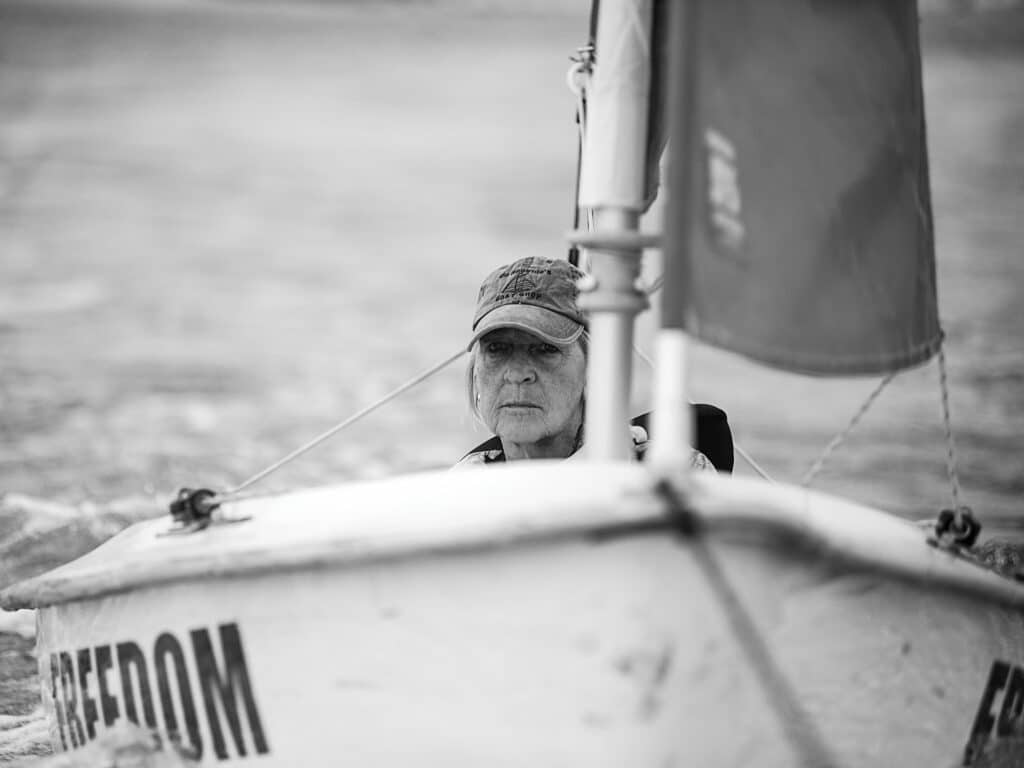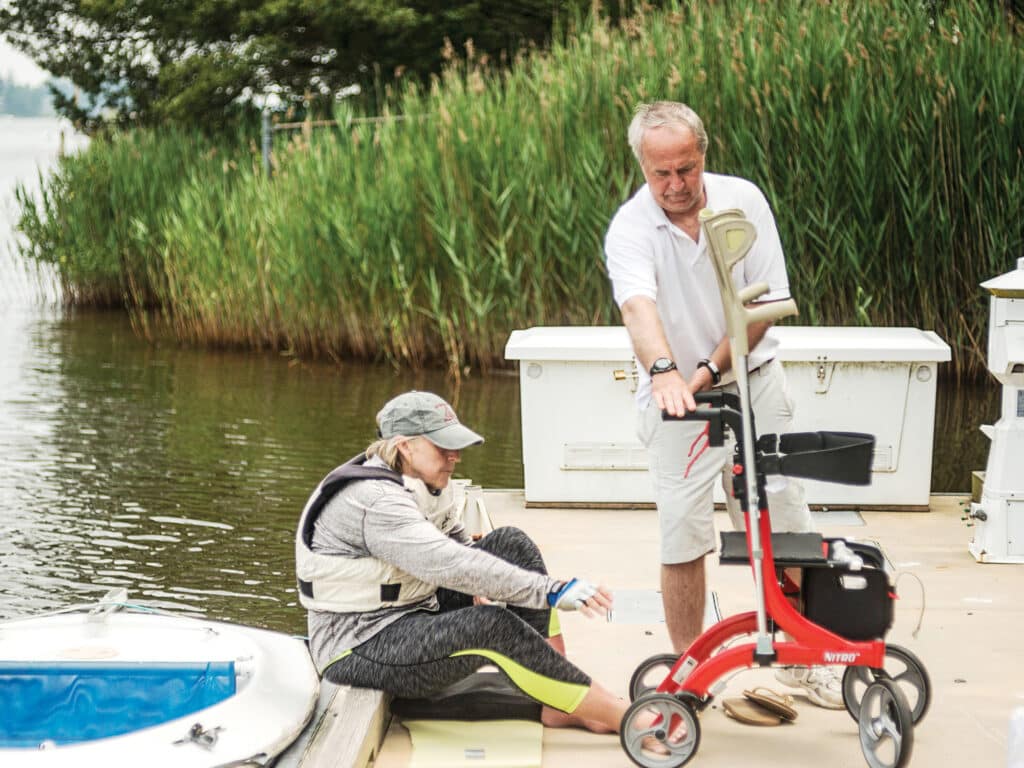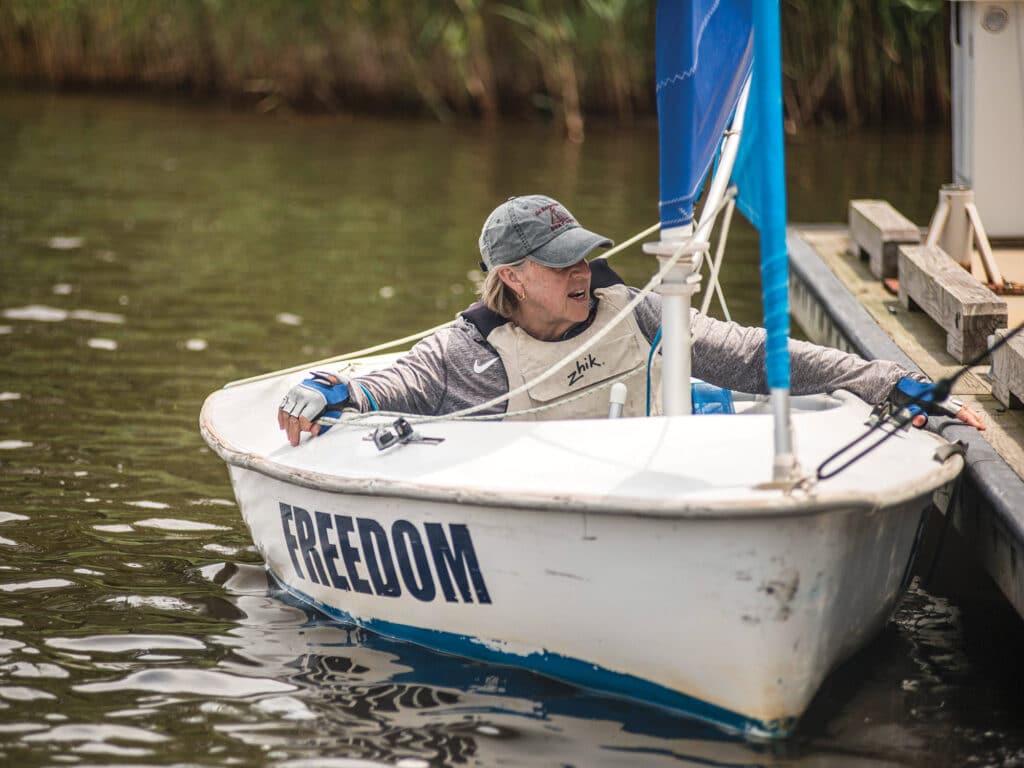
When the Rolex International Women’s Keelboat Championship was the pinnacle regatta for every aspiring female, Betsy Alison and her team were annoyingly unbeatable. They won the inaugural event in 1985, and 12 years later, after winning four in a row, the original trophy was retired in Alison’s name. She is the only five-time winner of the Rolex Yachtswoman of the Year Award, and she is the first woman inducted into the National Sailing Hall of Fame, part of the first class in 2011. After years of racing both with and against her, I can tell you that she practices hard, races even harder, and never, ever gives up. And in an ironic twist of fate, Alison is proving this to be true once again.
In 1998, Alison was hired to coach the US Paralympic Sailing Team. “When I started, I didn’t know anything about disability,” she says. “I learned on the job; I didn’t have any medical training.” She obviously figured it out because Team USA won at least one medal at every Paralympic Games until the sport was dropped in 2016. She continues to advocate for its inclusion because, as she once said, “It is really incredible to see what I think is an underserved group of people that are athletes, who have a competitive mind [but] don’t let circumstances affect their outlook and pursuits.”
In August 2022, a tumor in her left hip gave Alison what Paralympic athletes call an “acquired disability.”
“I spent over 20 years coaching Paralympic and disabled sailing, Para Sailing as we call it now,” she clarifies as she leans back in her wheelchair and rubs at her left leg, trying to help its blood flow. We’re in her living room and home office, surrounded by memorabilia and the detritus of a busy life. “Now I’m learning how to walk again.”
At first, she says, the oncologists didn’t believe their own test results. “It is a rarity that you would ever see squamous cell carcinoma in the bone and muscle because it’s a skin cancer.”
Laughing, she adds, “I’m a party of one. And I was super lucky that it hadn’t spread anywhere else.”
After chemo and radiation shrank the tumor, two surgeons spent nine hours extracting what was left of the mass from her left hip. She lost about 90 percent of the muscle mass that controls the joint. “I didn’t know whether I was gonna come out with a leg or not; nobody knew. And I am missing half my pelvis; none of that’s ever coming back.”

In rehab, she found herself making suggestions to the physical therapists: “Hey, can we try this way? I think this might work better. And sometimes they learned something from me; sometimes their way was better. But it was that testing process, thinking about the steps. That’s what I learned from coaching the Paralympic sailors. They’d tell me what worked best for them.”
Perhaps the biggest challenge was heeding her own advice. “Part of my whole coaching philosophy was like, look, I’m going to push your limits, and I’m going to ask you to do things that may be uncomfortable, or challenge you to try things that you think you can’t do. But if you can, yay—that opens up a new window.” Whenever one of her athletes said they couldn’t do something, she would tell them: “Prove to me you can’t do it. You have to maximize abilities and minimize the impact of the disability.”
Now that she’s coaching herself, she’s adopted this same mindset, “regardless of how painful it is.”
Before I can ask for an example, she provides one. “When I first came home, I would force myself to stand up from the wheelchair.” She grips its padded arms, shifts herself forward, and grimaces as she presses to her feet. “It’s still really hard, and I can’t stand for long periods of time, but I force myself to reach for things, do the proprioception to challenge myself, even though it’s uncomfortable. Because the only way I’m going to learn is to just do it.”
Next, she grabs a nearby walker and takes a very mindful step. “It’s so weird because those motions you take for granted… My brain thinks I can get there, but my body can’t execute it yet. I have to really think about engaging my hip flexor and lifting my leg, then going heel…toe…bending the knee. I’m really trying to learn good form again. Form is everything. It’s technical, and it’s hard.”
The result of all this self-motivated tough love has been a relatively fast recovery. Her smile stretches to maximum width when she boasts, “Every time I see [my surgeons], I’m exceeding their expectations.” Before her surgery, one doctor gave a best outcome that Alison would eventually be able to walk with two canes. Then she walked into her first post-surgical visit using just a walker. “They’re shocked that I’m walking as much as I am. They just shake their heads, like, we don’t get it—but it’s pretty awesome!” Predictions were quickly upgraded to one cane by year’s end. But, of course, Alison set her own sights even higher: “My whole goal is to be walking with no cane. That’s what I keep working toward.” She lands back in her chair, grimacing again.
“The big thing for me is going to be the day that this leg”—she waves at her left knee— “comes up off the floor on its own. That is going to be a huge day. I feel the muscles firing; I just can’t execute yet.”
Alison is excited that the Para Worlds are part of the Allianz World Sailing Championships in The Hague, Netherlands, but when we spoke, she hadn’t yet sailed a Hansa 303, the platform for the women’s singlehanded discipline. “I don’t even know if I’ll have to use a lift to get into the boat,” she admits, “or how I get out. I have a hard time dragging this leg. I don’t know what I’m gonna be able to do.”
Just getting on an airplane brings new questions. “Do I take arm crutches with me or a walker? Will I need it? I don’t know.” She’s handled such logistics many times before for other athletes. “I was always there to assist them. Now it’s trial by fire; just get on and see what happens. And yeah, it’ll be a challenge.”
Before racing starts, each athlete must be classified by degree of disability. “It’s a slew of testing, from mobility to stability to hand function. Obviously, my hands are fine.” Alison knits two sets of strong fingers together under her left thigh to raise it a few inches. “So, it’s more the mobility factor. And I don’t have a tremendous amount of strength, but I’m trying all the time.”
She doesn’t know what her classification will be, though she’s expecting a minimum disability. “And it’s gonna hurt like heck,” she predicts because the classifiers will push the edges of her range of motion. “But I gotta figure it out.”
Her primary reasons for sailing the Para Worlds are drastically different from any of her regattas as an able-bodied sailor or coach. It’s a milestone to meet in her recovery and a motivator for others. “It’s not easy; it’s painful, it sucks,” she says. “But you know you can do these things. So that was my motivation for going.”
But when I ask about the competition, her trademark game-face grimace returns. “I haven’t even looked; it doesn’t matter to me. I’m sure I’ve never sailed against any of these people. So, I won’t have the baggage of thinking, ‘Oh, this person is really good.’”
It reminds her of her first international regatta, in 1978, which was also a singlehanded women’s event (in a boat then known as the Laser). “I didn’t really know any of the foreign competitors, so that’s how I’m going into this. I don’t know who they are, and I don’t care because they’re just another boat to get around.”
Once on the water, it will be just like any other regatta, she insists. “I know how to start; I’m not worried about that. And the boats are simple enough; it’s just a question of figuring out what they’re quirky with. I’ll talk to other coaches. I’ll talk to other sailors, figure out what they’re doing or watch how they’re setting up. I’ll learn about sailing these boats.”

The United States is sending five Para sailors to compete in the four disciplines, and the group selected Alison as its team leader. “Just because I’ve done these things so many times before,” she says, adding, “I try to keep them organized.” But she is also consciously saving energy for herself. “The Worlds is a stretch goal,” she reminds me. “But am I motivated to put in the best performance that I can? Absolutely. You can’t not; that whole competitive side of you comes up. For the first half of the regatta, I’m just gonna go for the best finishes. And then when I get down to the end, I’ll know who the players are. And that’s who I’ll base my strategy around. But first things first, I have to learn how I get in [and out of] the boat! Can I slide side to side? What adaptations, if any, do I need?”
Paralympic gold medalist Maureen McKinnon, who is sailing the doublehanded RS Venture Connect with Shan McAdoo, is as impressed as Alison’s doctors with the speed of her former coach’s recovery. “She’s gone through cancer diagnosis, cancer surgery, cancer recovery. And now, in less than a year, she’s back on a boat. It is pretty crazy.”
When I thank Alison for sharing her incredibly ironic—and inspiring—journey, she shrugs her broad shoulders.
“You don’t know what you don’t know,” she says. “Talk about sailing in uncharted waters. People look at the X-rays, and they go, ‘We don’t know how you’re walking!’ I don’t know either, but I’m doing it. I think a lot of it is mind over matter and training your body to do what it needs to do. And if we push a limit and it can’t go any further, then so be it.”
Though still rubbing that left leg, she’s smiling again. “It really is such a unique position to find myself in because I never thought I would be on this side of the equation. So much of what I learned I have applied to my own rehab. And there’s nothing easy about it.”
Nothing easy, but that’s her way: Train hard, race harder, and never, ever give up.









